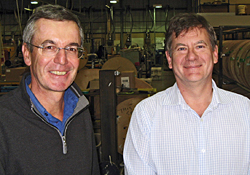
If you have attempted to make a bird out of paper you will know that unless you fold the paper in exactly the right place, what should look like a parrot can end up looking more like a horse. The same problem confronts manufacturers of cardboard boxes. For the box to have nice regular oblong lines and fit together as it should the cardboard has to be folded along exactly the correct axis.
But I am not here to give you a lesson in origami. I am here to tell you about a company that is prospering by solving this ticklish problem. The company is called C & T Matrix, and last week I went along to Wellingborough to meet a great example of a small but successful British manufacturing company.
Welcome to the first of a new series for Penny Sleuth – a series in which I will report back on my quest to find the next great British innovator. I have discovered a few great stocks in the last year on home soil.
But the point is this: you don’t find great penny shares by simply trawling through analyst reports and the newspapers. If you want to know what things are really like you need to get out and about and see them with your own eyes. After all, how many holiday resorts have you ever been to that have been anything close to their description in the brochure or in your own imagination?
Rather than reading about things, I like to see them for myself. And I like to meet the people – that’s me with C & T’s chief operating officer, Ian Roberts, in the picture, on the factory floor.
Let me explain the kind of company Ian Roberts is running…
The bizarre world of cardboard packing
C & T is a subsidiary of AIM-quoted Plastics Capital (AIM: PLA), which has a strategy of acquiring small businesses making plastic products with a niche application and good profit margins. C & T is an excellent example. Each and every day it despatches its products all over the world. It has only one competitor of any scale and, give or take a little market share, it should be able to grow and prosper for many years. But let me tell you how it solves the problem of folding cardboard.
Any box of carton starts with a flat sheet of card. Its shape is stamped out, and within this shape various indentures are made – lines along which the card will naturally fold. When the Christmas cards start to arrive you will see the same thing, a depressed line along the card along which it folds.
Well! I think you probably knew that already! But how does the manufacturer get that fold line in exactly the right place, knowing that if it is just a fraction off centre the whole thing will be ruined?
The answer is that a blunt blade is pressed against the card, pushing it down into a small channel underneath. This channel has traditionally been made by somebody placing two parallel lines of material along either side of a line. In order to get these lines in exactly the right place carbon paper is sometimes placed on the blunt blade which, when pressed down leaves a blue print on the line where it will fall. If this sounds like a complicated and time consuming process, it is. But the biggest problem, apart from getting the channel in the correct position, is that while this is going on the machine cannot be making boxes.
C&T is fast expanding across Asia
It’s a bizarre niche. The kind of story that could so easily pass you by. I don’t think I would ever have taken an interest in cardboard manufacturing without having visited Wellingborough. But there is a great business here.
C & T Matrix makes a ‘self-locating creasing matrix system’ that has been patented for forty years. Essentially it allows the small channel to be pressed into exactly the correct position directly by the blunt blade itself, thereby ensuring without any doubt that it is in the right place. This creasing matrix system is made in various sizes out of extruded plastic or, more recently, pressed fibre board.
As I walked around the factory floor I saw long streamers of plastic, heated and then formed into the correct shape, cooled, fitted together with other components and then cut to size. C & T Matrix sends out thousands of boxes of these matric systems week, an increasing number of which end up in India and other countries in the developing world.
While this type of creasing system is commonly used in the developed world, it has not yet been widely adopted elsewhere and C & T is determined to seize the opportunity. It is already educating potential customers in the printing trade, and selling both directly and through distributors in India, China and beyond.
It is great to see a small manufacturing company with a genuine global presence. C & T should be both resilient during a recession and able to grow over the long term. It is the type of business that tends to be under-rated on the stock market – and Plastics Capital, which owns three similar companies and yesterday reported a 10% increase in its interim profits, trades on a PE ratio of under six. On the evidence of my visit to Wellingborough, I’d say it was worth a bit more than that.
• This article is taken from Tom Bulford’s free twice-weekly small-cap investment email The Penny Sleuth. Sign up to The Penny Sleuth here.
Information in Penny Sleuth is for general information only and is not intended to be relied upon by individual readers in making (or not making) specific investment decisions. Penny Sleuth is an unregulated product published by MoneyWeek Ltd.